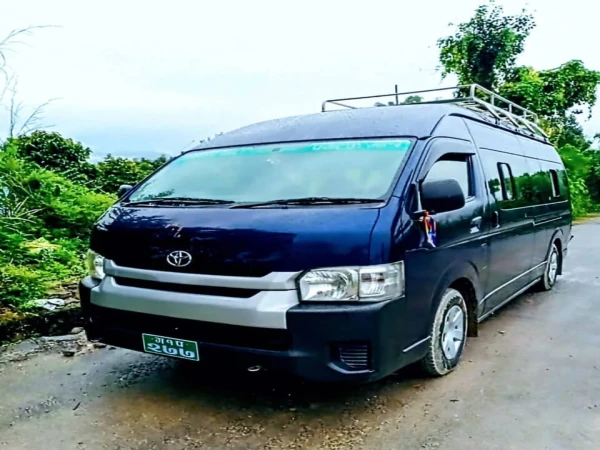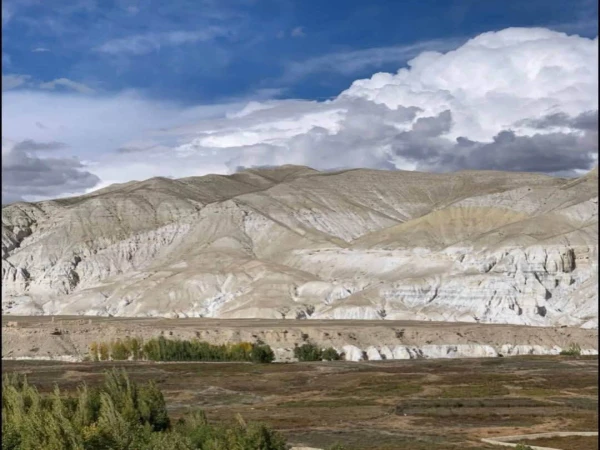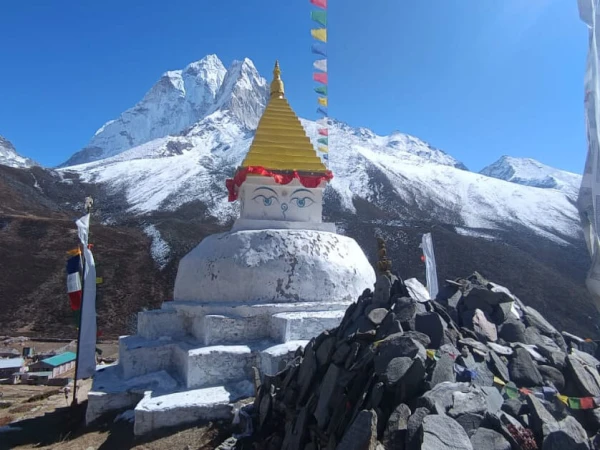In the vast, formidable amphitheater of the Nepalese Himalayas, where peaks pierce the stratosphere like shards of glass, one mountain holds a unique and profound allure. It is not Everest, with its global fame, nor Annapurna, with its fearsome reputation. It is Manaslu, the “Mountain of the Spirit.” Soaring to 8,163 meters, the world's eighth-highest peak is a serrated wall of snow and ice, a colossal pyramid of divine proportion that has captivated mountaineers, trekkers, and spiritual seekers for generations.
Its name, derived from the Sanskrit word manasa—meaning "intellect," "soul," or "spirit"—hints at its deep significance. For the communities living in its shadow, it is a sacred abode of deities, a protector whose moods dictate the fortunes of the valleys below. For climbers, it is a supreme test of skill, endurance, and courage, a mountain known for its technical challenges and its unforgiving, avalanche-prone slopes. For trekkers, its circumambulation offers one of the most culturally rich and visually spectacular journeys on Earth, a path that winds through ancient salt-trading routes, remote villages, and a breathtaking spectrum of landscapes.
This guide is a deep dive into the world of Manaslu. We will journey through its geography and its six climatic zones. We will uncover its dramatic and often tragic climbing history, from the first Japanese expeditions to the modern era of record-setting and heartbreaking loss. We will explore the formidable risks—the avalanches and the infamous false summit—that make it one of the most dangerous 8000ers. We will walk, step-by-step, along the famed Manaslu Circuit, and we will meet the resilient people who call this sacred region home. Finally, we will discover the vibrant ecosystem that the Manaslu Conservation Area strives to protect. This is the complete story of Manaslu, the Mountain of the Spirit.
The Grand Architecture of Manaslu: Geography, Climate, and Landscape
Manaslu is the crowning jewel of the Mansiri Himal, a range in the west-central part of Nepal. It is a commanding presence, bordered to the east by the Ganesh Himal and to the west by the deep, canyon-like fissures of the Marysyangdi Khola, with the mighty Annapurna range looming beyond. This is the heart of the Gorkha District, a region of immense historical and cultural importance to Nepal.
The mountain itself is a spectacle of geological force. Its three-sided pyramid culminates in a double-edged summit that towers steeply over the surrounding landscape. Its long ridges and glacial valleys offer multiple, albeit uniformly challenging, approaches to the top. Important satellite peaks stand guard around the main summit, forming a court of giants: the elegant Himalchuli at 7,893 meters, the formidable Ngadi Chuli at 7,871 meters, and the more distant Baudha at 6,672 meters.
What makes the Manaslu region so unique is its incredible vertical relief and the corresponding diversity of its climatic zones. To journey from the trailhead of the circuit to the mountain's base camp is to travel through entire continents of ecological change in a matter of days.
- The Tropical and Sub-tropical Zone, from 600 to 2,000 meters: The journey begins here, in the hot, humid lowlands carved by the Budhi Gandaki River. Terraced fields of rice and millet cling to the hillsides. The air is thick with the scent of lush vegetation, and the temperatures can be sweltering, with summer averages between 31 and 34 degrees Celsius.
- The Temperate Zone, from 2,000 to 3,000 meters: As the trail gains altitude, the landscape transforms. Broadleaf forests of oak, maple, and rhododendron dominate. The air becomes cooler and crisper, with summer temperatures a pleasant 22 to 25 degrees Celsius. In winter, frost is common, and the first dustings of snow may appear.
- The Sub-alpine Zone, from 3,000 to 4,000 meters: This is where the true high-mountain feeling begins. The broadleaf trees give way to forests of Himalayan blue pine, fir, and birch. Villages become more sparse. The views open up to reveal the high peaks. Snowfall is common from December to May, and the mean annual temperature hovers between 6 and 10 degrees Celsius.
- The Alpine Zone, from 4,000 to 5,000 meters: Above the treeline, the landscape becomes a vast expanse of meadows, tundra, and scrub juniper. This is the land of yaks and high-altitude pastures. The air is thin, and the sun is intense. Here, the challenge of altitude becomes a constant companion.
- The Arctic Zone, above 4,500 meters: This is the domain of rock, snow, and ice. Lying above the permanent snow line at around 5,000 meters, this zone is a world of profound silence and raw beauty, where temperatures remain largely below freezing year-round. It is the realm of the mountaineer, a landscape sculpted by glaciers and the unforgiving Himalayan elements.
The Climbing History of Mount Manaslu
The climbing history of Manaslu is a compelling saga of national pride, groundbreaking achievements, and devastating loss. For decades, it has been known as "the Japanese Mountain," a testament to the nation's relentless and ultimately successful quest to conquer its summit.
Early Reconnaissance and the Hostile Gods
The first European to lay eyes on a feasible route was the venerable British explorer H. W. Tilman in 1950. During a reconnaissance of the Annapurna range, he saw Manaslu from the Larkya La pass and noted a potential line to the summit, though he made no attempt.
The real story, however, begins with the Japanese. Between 1952 and 1955, four separate expeditions threw themselves at the mountain's north and east faces. Each was repelled by the immense scale of the peak and brutal weather. But they faced another, more unnerving, obstacle. In 1954, a Japanese team arrived at the village of Samagaon to find themselves facing a hostile council of elders. The villagers, devout Buddhists, believed that the previous expeditions had angered the mountain's deities. They attributed a recent avalanche, which had destroyed the sacred Pung-gyen Monastery and killed 18 people, directly to the presence of the foreign climbers. The Japanese team was forced into a hasty retreat.
The First Ascent and Subsequent Milestones
The Japanese were determined. To appease local sentiments, they made a large donation to rebuild the monastery. In 1956, a new expedition led by the respected Yuko Maki returned. Though tensions remained, they were allowed to proceed. On May 9, 1956, after a grueling ascent, Toshio Imanishi and Gyaltsen Norbu Sherpa stood on the true summit of Manaslu. It was a moment of immense national pride for Japan and a landmark achievement in Himalayan mountaineering.
The 1970s - An Era of Innovation and Loss
The 70s were a golden, yet brutal, age on Manaslu.
- In 1971, a Japanese team summited via the difficult northwest spur.
- In 1972, the legendary Tyrolean climber Reinhold Messner made a bold and audacious solo ascent of the formidable southwest face, a feat that cemented his reputation as one of the greatest mountaineers of all time.
- The decade was also marked by one of Manaslu's greatest tragedies. In 1972, a massive avalanche struck the camp of a Korean expedition at 6,500 meters, burying and killing 15 climbers, including 10 Sherpas and the expedition leader, Kim Ho-sup.
- In 1974, an all-female Japanese expedition made history. Led by Kyoko Sato, they became the first women to successfully climb an 8,000-meter peak. Sadly, their triumph was marred when one climber fell to her death during the descent.
The 1980s - New Routes and Winter Firsts
The spirit of exploration continued.
- The first British ascent was recorded in 1983.
- On January 12, 1984, Polish climbers Maciej Berbeka and Ryszard Gajewski achieved the coveted first winter ascent via the normal route, a brutal undertaking in the harshest of conditions.
- In 1986, the phenomenal Polish mountaineer Jerzy Kukuczka, a rival to Messner for the first ascent of all 14 eight-thousanders, established a challenging new route on the East Ridge.
The Modern Era (1990s-Present)
- In 1996, Mexican climber Carlos Carsolio summited Manaslu, making it his 14th and final eight-thousander, becoming only the fourth person in history to achieve this monumental feat.
- The 21st century has seen an increase in commercial expeditions, but the mountain has continued to demonstrate its power. Australian mountaineer Sue Fear died after falling into a crevasse in 2006. In 2011, Arjun Vajpai of India became the world's youngest climber to summit Manaslu at just 18 years old.
- In September 2012, another horrific avalanche swept down the mountain, killing eleven climbers.
- The autumn of 2022 was particularly tragic. First, an avalanche killed Nepali guide Anup Rai. Days later, world-renowned American ski mountaineer Hilaree Nelson died after falling over 1,800 meters from the summit ridge while attempting to ski down with her partner, Jim Morrison. Her death sent shockwaves through the global mountaineering community.
The Perils of the Peak: Avalanches and the Deceptive Summit
Manaslu is statistically one of the most dangerous 8,000-meter peaks. Its fatality rate places it alongside infamous mountains like Annapurna and K2. The dangers are twofold: the objective hazard of avalanches and a unique topographical feature that has led to widespread confusion and controversy.
- The Unforgiving Avalanches: The mountain's geography, particularly on the north side (the normal route), creates a natural funnel for avalanches. The route between Camp 1 and Camp 2 is notoriously exposed. The vast, serac-laden ice cliffs that loom above are prone to collapsing without warning, sending tons of snow and ice hurtling down the slopes. The tragedies of 1972, 2012, and 2022 are stark reminders of this ever-present danger.
- The False Summit Controversy: A significant challenge on Manaslu is its summit topography. The point that most climbers reach is a fore-summit, or a "false summit." The true, highest point lies further along a long, treacherous, and highly exposed corniced ridge. For years, many climbers, exhausted and battling hypoxia, stopped at this fore-summit, believing they had reached the top. In 2021, a meticulous investigation by a team of international experts, including the chronicler Eberhard Jurgalski, used photographic evidence and satellite data to report that the vast majority of climbers who had claimed to have summited Manaslu had, in fact, stopped short of the true peak. This revelation has sent ripples through the climbing community, forcing a re-evaluation of historical ascents and placing a new emphasis on reaching the verifiable true summit.
A Journey for the Soul: The Manaslu Circuit Trek
For those who wish to experience the majesty of Manaslu without the extreme risks of a summit attempt, the Manaslu Circuit offers one of the world's greatest treks. This 177-kilometer journey circumnavigates the entire Manaslu massif, offering an unparalleled experience of both natural beauty and cultural immersion. Opened to tourism only in 1991, it remains less crowded and more pristine than the popular Annapurna and Everest treks.
A Section-by-Section Guide to the Circuit:
- The Beginning (Arughat/Machha Khola to Jagat): The trek typically starts from Arughat Bazaar or, more commonly now, Soti Khola. The first few days are spent in the hot, subtropical Budhi Gandaki valley. The trail is a rollercoaster, climbing and descending through terraced fields, Sal forests, and traditional Gurung villages.
- Entering the Restricted Area (Jagat to Deng): At Jagat, you enter the Manaslu Restricted Area. The trail becomes narrower as it enters the deep gorge of the Budhi Gandaki. You'll cross numerous suspension bridges, often high above the roaring river.
- The Buddhist Heartland (Deng to Samagaon): From Deng onwards, the culture begins to shift palpably. The influence of Tibetan Buddhism becomes more pronounced. You'll pass intricate mani walls, which are stones carved with Buddhist prayers, as well as chortens and prayer wheels. In villages like Lho, you get your first staggering, head-on view of Manaslu. The trail climbs to the large village of Samagaon at 3,530 meters, which sits on a wide plateau at the foot of the mountain. This is a crucial acclimatization stop, with a beautiful monastery and an optional day hike to Manaslu Base Camp.
- The High Plateau (Samagaon to Samdo): The trail continues to the even more remote village of Samdo at 3,860 meters, the last major settlement before the pass. This is a village of Bhotia people and feels like a true outpost on the edge of Tibet. The views of the surrounding peaks, including Samdo Peak, are magnificent. Another acclimatization day here is essential.
- The Ascent to the Pass (Samdo to Larkya La): From Samdo, the trek enters its most challenging phase. The trail climbs to the high camp, known as Dharamsala or Larkya Phedi, at 4,480 meters. The final push to the Larkya La pass at 5,106 meters begins before dawn. It is a long, slow, and demanding ascent across glacial moraine, but the reward is one of the most breathtaking panoramas in the Himalayas. From the prayer-flag-draped summit of the pass, you are surrounded by a sea of peaks: Himlung Himal, Cheo Himal, Kang Guru, and the Annapurna massif in the distance.
- The Descent (Larkya La to Bimthang and Beyond): The descent from the pass is steep and often snow-covered. It leads down to the vast, beautiful meadow of Bimthang at 3,720 meters, which offers incredible retrospective views of Manaslu. From here, the trail descends rapidly through pine and rhododendron forests, joining the Annapurna Circuit trail at Dharapani before ending in Besisahar.
Logistics: Permits, Guides, and Season
The trek requires a Manaslu Restricted Area Permit, a Manaslu Conservation Area Permit (MCAP), and an Annapurna Conservation Area Permit (ACAP). A registered guide is mandatory, and you must trek in a group of at least two people. The best seasons are spring (March to May) and autumn (September to November).
People and Culture of the Manaslu Region
The Manaslu region is not just a landscape of rock and ice; it is a living cultural tapestry woven by the resilient communities who inhabit its valleys. The two main ethnic groups are the Nubri and the Tsum. In the central hills, the Gurungs are the dominant group, famed for their service in the British and Indian Gurkha regiments.
Closer to the Tibetan border, the culture is distinctly Tibetan. The Bhotias of the upper Budhi Gandaki valley are of Tibetan origin, and their way of life is deeply intertwined with Tibetan Buddhism. Their flat-roofed stone houses, their traditional dress, and their language all reflect this heritage. The entire region is a spiritual landscape, dotted with ancient monasteries like the Pung-gyen and Mu Gompas, intricate mani walls, and sacred chortens that serve as focal points for religious life. For these communities, Manaslu is not merely a mountain; it is a deity, a powerful force to be respected and revered.
The Ecosystem of the Manaslu Conservation Area
Established in 1997, the Manaslu Conservation Area Project (MCAP) aims to conserve the region's unique natural and cultural heritage while promoting sustainable livelihoods for its people. Managed by the National Trust for Nature Conservation (NTNC), the 1,663 sq km area is a biological treasure trove.
- Fauna: The deep valleys and high slopes provide a sanctuary for many endangered and elusive species. The apex predator is the mythical snow leopard. The area is also a critical habitat for the red panda, Himalayan musk deer, grey wolf, Himalayan tahr, and blue sheep. Remarkably, a hunting ban, long enforced by the monks of local monasteries, has been one of the most effective conservation tools, allowing wildlife to prosper. Over 110 species of birds have been recorded, including the golden eagle, Himalayan griffon, and various species of pheasant.
- Flora: The region's dramatic altitude variation gives rise to an astonishing diversity of plant life. Nineteen different types of forests have been identified, from subtropical Sal forests to alpine birch and juniper. The hillsides in spring are set ablaze with the blooms of countless species of rhododendron. It is estimated that between 1,500 and 2,000 plant species grow here, many of which are valuable medicinal and aromatic herbs that have been used in traditional medicine for centuries.
Conclusion: The Enduring Spirit of Manaslu
Manaslu is a mountain of profound duality. It is a place of sublime beauty and immense danger, of spiritual tranquility and extreme physical hardship. It is a mountain that has been the stage for some of mountaineering's greatest triumphs and its most heartbreaking tragedies.
To climb Manaslu is to engage with the raw, untamable power of the Himalayas. To trek its circuit is to walk through a living museum of culture and a world of staggering natural beauty. Whether you are a climber seeking the ultimate challenge, a trekker in search of adventure, or a traveler looking to connect with a landscape and a people untouched by time, Manaslu offers a journey that will test your limits, enrich your soul, and leave an indelible mark on your spirit. It truly is, in every sense of the word, the Mountain of the Spirit.
Frequently Asked Questions (FAQ) about Mount Manaslu
How high is Mount Manaslu?
Mount Manaslu is 8,163 meters high, making it the eighth-highest mountain in the world.
What does "Manaslu" mean?
The name comes from the Sanskrit word manasa, which translates to "mountain of the spirit" or "soul."
Who first climbed Manaslu?
Toshio Imanishi of Japan and Gyaltsen Norbu, a Sherpa guide, made the first successful ascent on May 9, 1956.
When is the best time to trek the Manaslu Circuit?
The best seasons are spring (March, April, and May) and autumn (September, October, and November) for stable weather and clear views.
How difficult is climbing Manaslu?
Manaslu is considered one of the more dangerous 8,000-meter peaks due to significant avalanche risk and technical sections, including navigating a long, exposed ridge to the true summit past a false peak.
What permits are needed for the Manaslu trek?
You need a Manaslu Restricted Area Permit, a Manaslu Conservation Area Permit (MCAP), and an Annapurna Conservation Area Permit (ACAP). Trekkers are also required to travel in a group of at least two persons with a registered guide.
You can book a safe and best Manaslu Regions trek with Himalayan Partners
Book Manaslu Region Trekking


.webp)


